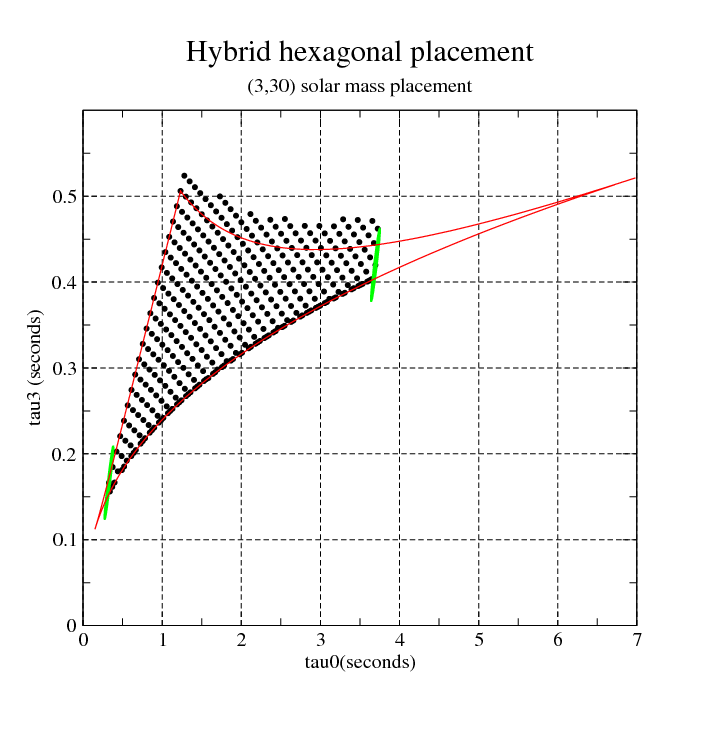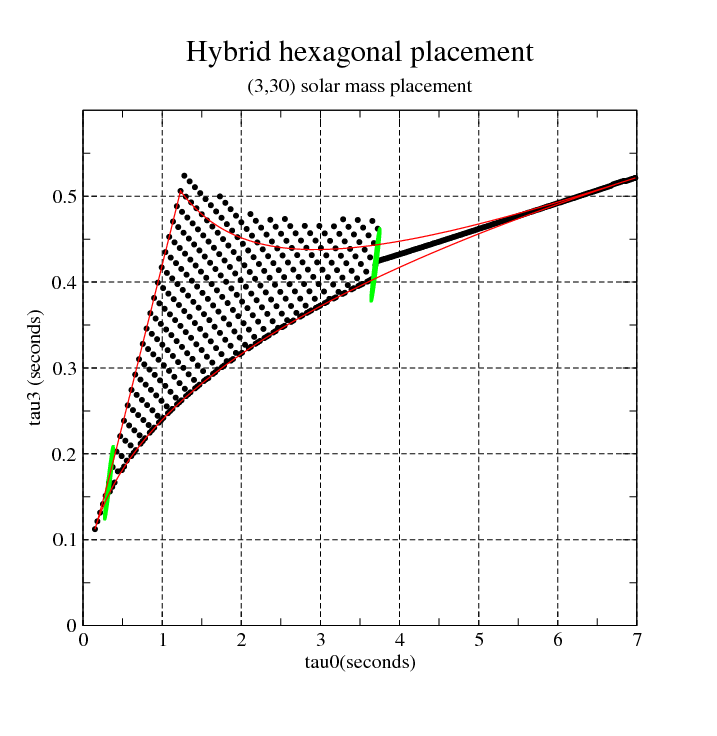Hybrid hexagonal template bank.
This code does almost the same as the standard Hexagonal Bank code. However, once the templates cover both the equal line and an other line ( \(m_1=\textrm{mMin}\) or \(m_2 =\textrm{mMax}\)), then there is no need to carry on any square/hexagonal placement. One can simply populate templates along a bissectrice.
The algorithm is identical to the hexagonal placement. However, once a template covers both the equal mass line and the upper boundary, then the hexagonal placement stops. So, an additional placement is needed to finalise the bank. In principle the placement needs to be completed on bothe side of the template bank, at low mass and high mass. So, we should start from the two templates which covers the two boundaries and populate the parameter space along a bissectrice.
The coordinates of the bissectrice at a given \(tau_0\) coordinate is estimated by tracing a vertical line in the \(\tau_0/tau_3\) plane, estimate the vlue of \(tau_3\) on the upper boundary and low boundary ( \(\eta=1/4\) line), and finally take the mean of the two values. Although, is is an approximation since we should also take into account the orientation of the ellipse, we think this is good enough. The vertical line crosses the parameter space on the \(\eta=1/4\) line and the other parameter space boundary which is define either by (1) \(m_1=variable\) and \(m_2=mMin\) or (2) \(m_1=variable\) and \(m_2=mMax\). Concerning (1), \(\eta=1/4\), this is a trivial computation, since
\begin{equation} \tau_3 = \frac{ A3}{\eta} \left( \frac{\eta \tau_0}{A0} \right)^{2/5}, \end{equation}
which in the case of \(\eta=1/4\) simply becomes :
\begin{equation} \tau_3 = 4 A3 \left( \frac{\tau_0}{4 A0} \right)^{2/5}. \end{equation}
In the case (2), if \(\tau_0\) is provided, if we can extract the total mass and \(\eta\) parameter, then \(tau_3\) is given by
\begin{equation} \tau_3 = \frac{ A3}{\eta} M^{-2/3}. \end{equation}
So, we need \(M\) and \(\eta\). Starting from
\begin{equation} \tau_0 = \frac{ A0}{\eta} \left( M \right)^{-5/3}, \end{equation}
we can extract a cubic equation
\begin{equation} x^3 - px+q=0 \end{equation}
where \(x = M^{1/3}\), \(p = -\frac{A0}{\tau_0/m_\textrm{Extreme}}\) and \(q= - m_\textrm{Extreme}=0\). \( m_\textrm{Extreme}\) is either set to mMin or mMax depending on which side of the parameter space we are.
The solution for \(x\) is standard and takes the expression :
\begin{equation} x = \left(-\frac{q}{2}-\frac{1}{2}*\sqrt{\frac{27 q^2 + 4 p^3}{27}}\right)^{\frac{1}{3}} + \left(-\frac{q}{2}+\frac{1}{2}*\sqrt{\frac{27 q^2 + 4 p^3}{27}}\right)^{\frac{1}{3}}; \end{equation}


Prototypes | |
| void | LALPopulateNarrowEdge (LALStatus *status, InspiralMomentsEtc *moments, InspiralCell **cell, INT4 headId, InspiralTemplate *paramsIn, HexaGridParam *gridParam, CellEvolution *cellEvolution, CellList **cellList, INT4 flag) |
| void | LALInspiralCreatePNCoarseBankHybridHexa (LALStatus *status, InspiralTemplateList **list, INT4 *nlist, InspiralCoarseBankIn coarseIn) |
| REAL8 | XLALInspiralBissectionLine (REAL8 tau0, REAL8 fL, REAL8 mMin, REAL8 mMax) |
| void LALPopulateNarrowEdge | ( | LALStatus * | status, |
| InspiralMomentsEtc * | moments, | ||
| InspiralCell ** | cell, | ||
| INT4 | headId, | ||
| InspiralTemplate * | paramsIn, | ||
| HexaGridParam * | gridParam, | ||
| CellEvolution * | cellEvolution, | ||
| CellList ** | cellList, | ||
| INT4 | flag | ||
| ) |
Definition at line 543 of file LALInspiralHybridHexagonalBank.c.
| void LALInspiralCreatePNCoarseBankHybridHexa | ( | LALStatus * | status, |
| InspiralTemplateList ** | list, | ||
| INT4 * | nlist, | ||
| InspiralCoarseBankIn | coarseIn | ||
| ) |
Definition at line 110 of file LALInspiralHybridHexagonalBank.c.
Definition at line 507 of file LALInspiralHybridHexagonalBank.c.